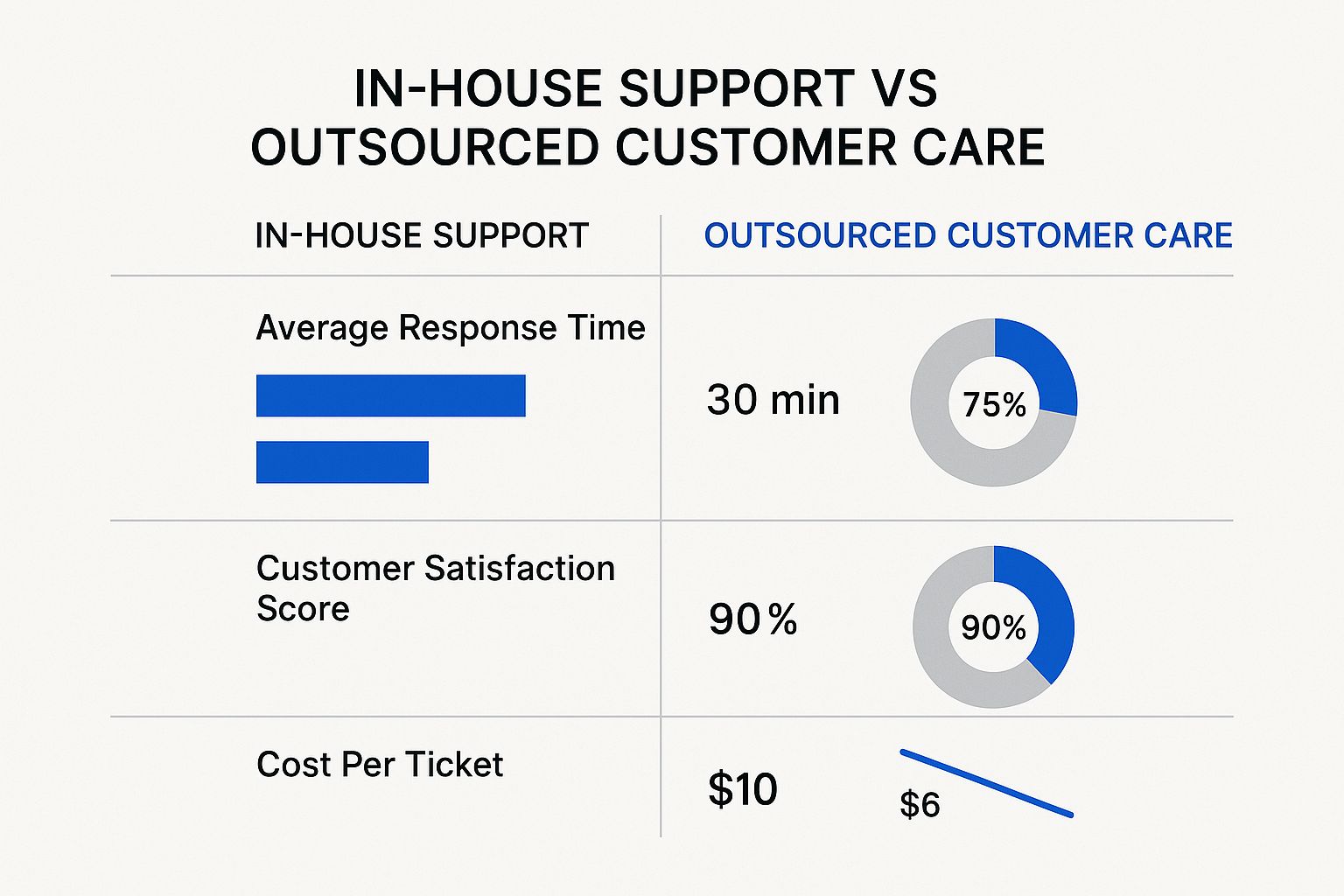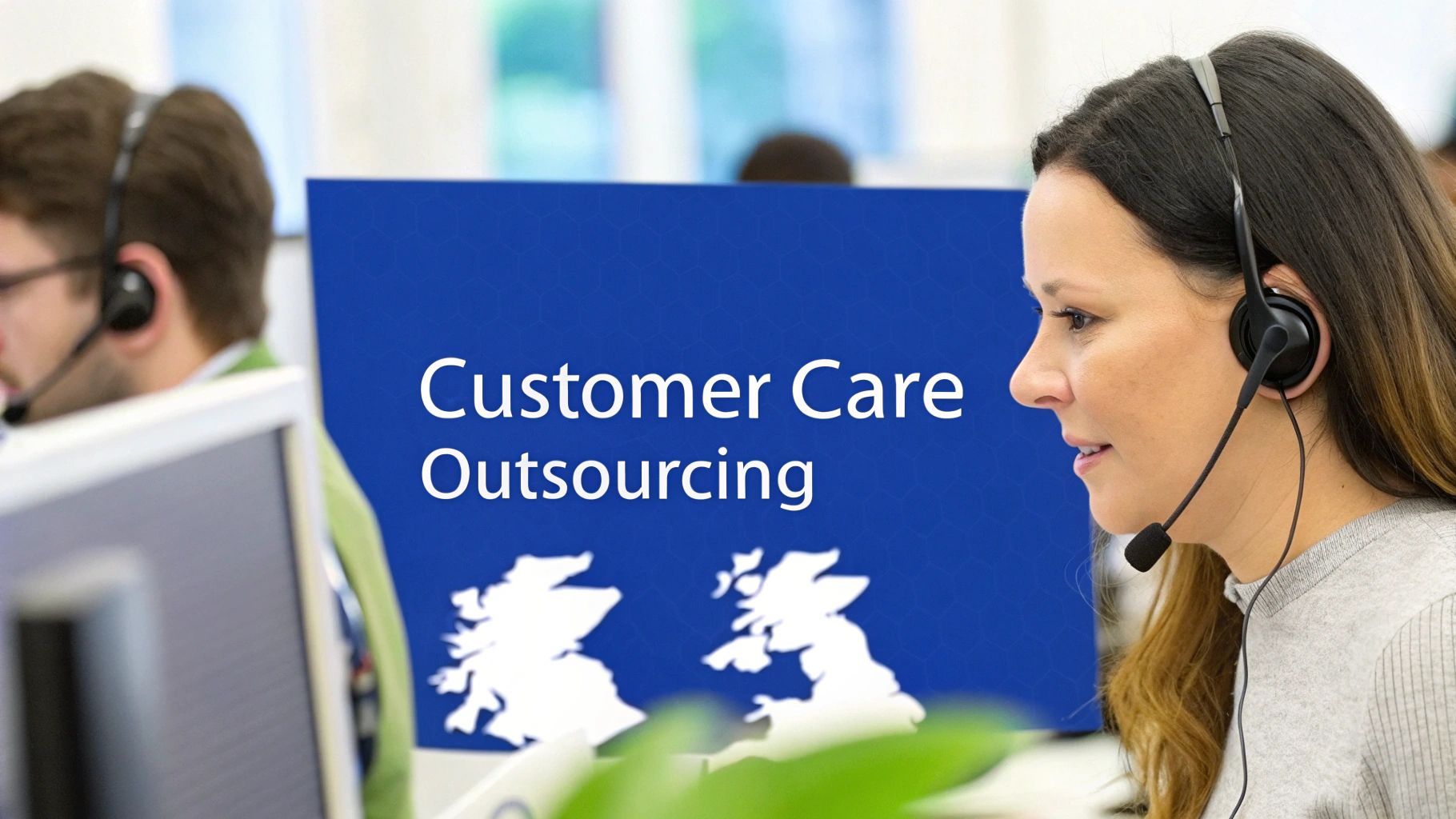Right, let's get into what customer care outsourcing actually means for a business. It’s far more than just getting someone else to answer your phones.
What Is Customer Care Outsourcing Really About?
Forget the dry, textbook definitions for a moment. Think of it this way: imagine a brilliant London restaurant, famous for its incredible main courses. Instead of trying to master the complex art of pastry on the side, they partner with a specialised patisserie to create their desserts. The result? The restaurant's chefs can focus on what they do best, and the customers get a world-class dessert menu.
That’s customer care outsourcing in a nutshell. UK businesses choose to partner with an external expert to manage their customer conversations—be it over the phone, via email, or on live chat. It’s a strategic move that goes well beyond simply cutting costs. It’s about tapping into specialised skills, elevating the customer experience, and giving your business the flexibility to grow without the usual growing pains.
A Strategic Partnership, Not Just a Cost-Cutter
While the financial benefits are certainly attractive, the real magic of outsourcing lies in achieving operational excellence. When you entrust your customer-facing roles to a dedicated partner, you free up your internal team to focus on the core of your business—things like product innovation, marketing strategy, and driving sales. This focus is crucial, whether you're a scrappy startup or a large, established enterprise.
This approach brings some significant advantages to the table. Let’s take a look.
The table below provides a quick snapshot of the primary benefits your business can achieve by outsourcing its customer care functions.
Key Advantages of Outsourcing Customer Care
Ultimately, a strong outsourcing partnership allows you to tap into expertise and infrastructure that might otherwise be out of reach.
This strategic shift is a major reason why the UK's Business Process Outsourcing (BPO) market, which is the umbrella for customer care, is growing so consistently. Projections show the market is on track to hit around USD 31.46 billion by 2025, with steady annual growth. This boom is being driven by businesses in finance, healthcare, and telecoms all seeking more efficient, tech-savvy ways to serve their customers. You can explore more data about the UK BPO market and its drivers.
In essence, customer care outsourcing transforms a necessary operational function into a powerful competitive advantage. It’s about doing what you do best and entrusting the rest to a partner who can do it better.
This allows businesses of all sizes to offer world-class support that might otherwise be impossible. It levels the playing field, enabling smaller companies to compete with established giants on the quality of their customer service. For larger organisations, it provides the agility needed to adapt to changing market demands and maintain a consistently high standard of care across every single customer touchpoint.
What’s the Real Business Impact of Outsourcing?

Outsourcing sounds good in theory, but what does it actually do for a business? Let's get past the buzzwords. When you strategically outsource your customer care, the effects ripple through the entire organisation, touching everything from your finances to your team's morale and ability to innovate. It’s about creating real, measurable value, not just offloading customer queries.
The most immediate and obvious win is the reduction in your operational overheads. Running an in-house customer service team is a serious financial undertaking, and salaries are just the beginning. The costs quickly mount when you add recruitment, in-depth training, software licences, and the physical office space needed for your team. Outsourcing simply takes these items off your budget.
This frees up a significant amount of capital that you can pump back into the heart of your business. Instead of spending that money on support functions, you can channel it into product development, ambitious marketing campaigns, or expanding your sales team—the very activities that directly generate revenue and fuel growth.
Gaining Instant Expertise and Technology
Trying to build a world-class customer service operation from scratch is a massive undertaking. It’s not just about hiring the right people; it involves investing in sophisticated CRM systems, call centre platforms, and analytical tools. This process can easily take months, if not years, and it comes with a hefty price tag.
Customer care outsourcing lets you skip that entire development phase. When you team up with a specialist provider, you get immediate access to:
- Seasoned Professionals: You're not just hiring call agents. You’re tapping into a team with years of hands-on experience, proven methods, and a deep-seated understanding of what excellent customer service looks like.
- Advanced Technology: Reputable partners have already made the big investments in top-tier industry software, from AI-powered analytics to seamless omnichannel communication hubs.
- Established Processes: They come to the table with polished workflows for everything, from escalating tricky tickets to ensuring quality, which means you get efficiency and consistency right from day one.
This instant injection of expertise is a real game-changer. It means a small business can suddenly offer a level of customer care that rivals its biggest competitors, creating a powerful point of difference in a crowded marketplace.
Achieving Strategic Agility and Scalability
Business is rarely a straight line. Seasonal demand, a big promotional push, or rapid growth can cause customer enquiry volumes to spike without warning. For an in-house team, these swings are incredibly difficult to manage, often leading to burnt-out agents, long customer wait times, and a noticeable dip in service quality.
Outsourcing, on the other hand, gives you ultimate agility. A good partner can scale your support team up or down almost instantly, making sure you always have the right number of people to handle any volume. This flexibility means you can navigate a frantic Christmas period or a new product launch without the stress and cost of hiring temporary staff.
The real magic of outsourcing isn't just handing off tasks; it's about strategically reallocating your internal team's time and energy. When your best people are freed from managing routine support queries, they can focus on high-value, strategic initiatives that push the business forward.
This shift in focus is where the true, long-term value really emerges. It nurtures a culture of innovation and proactivity, rather than one stuck in a reactive loop. This is especially true for recruitment, where internal HR can focus on finding core team members instead of support staff. Our detailed guide explores the many benefits of outsourcing recruitment and how it can give your hiring a serious boost.
Here in the UK, customer care outsourcing has moved far beyond being a simple cost-cutting measure. A Deloitte study revealed that 78% of UK businesses are happy with their outsourcing partnerships, often pointing to improved customer satisfaction as a key reason. While cost savings still average between 25% and 40%, the conversation has shifted. Now, it's about gaining access to specialised skills and scalable solutions. This evolution proves that businesses now see outsourcing as a vital component for strategic growth, not just a tool for trimming the budget.
Choosing Your Customer Care Outsourcing Model
Picking the right partner for customer care outsourcing is only half the battle; you also need to land on the right operational model for your business. This is a big decision. It directly impacts everything from your budget and communication workflows to how well the team aligns with your company culture. Getting this right is fundamental to building a successful partnership that truly delivers.
To put it simply, think of it like sourcing ingredients for a restaurant. Your choice depends on your budget, your quality standards, and how closely you need to work with your suppliers. The three main models—onshore, nearshore, and offshore—each offer a unique mix of pros and cons.
Onshore Outsourcing: The Local Farm
Onshore outsourcing is like buying your produce from a local farm. The provider is based right here in the UK, just like you. This model gives you the tightest possible cultural and linguistic alignment, ensuring your brand's voice is perfectly captured.
Communication is effortless, with no time zone headaches to juggle. Plus, your partner operates under the same local regulations, like GDPR, which takes a lot of the complexity out of compliance and data security. The trade-off? Just like premium, locally-grown organic produce, this model comes with the highest price tag.
Onshore is ideal for businesses that simply cannot compromise on cultural synchronicity and brand voice. It's a must for those in highly regulated industries like finance or healthcare, where local compliance is non-negotiable.
Nearshore Outsourcing: The Neighbouring Market
Sticking with our analogy, nearshore outsourcing is like sourcing ingredients from a neighbouring country. Your customer care team is located somewhere geographically and culturally close to the UK—think Eastern Europe, for example.
This model strikes an excellent balance. You still get the benefit of minimal time zone differences, strong English skills, and a good grasp of UK culture. The big win here is the cost reduction. Labour and operational expenses are significantly lower than in the UK, but you avoid the major logistical hurdles of working with a team on the other side of the world.
Some of the key benefits you'll see with a nearshore partner include:
- Cost-Effectiveness: You'll see substantial savings compared to the onshore model.
- Cultural Proximity: The teams often have a strong, intuitive understanding of UK consumer expectations.
- Time Zone Alignment: Real-time collaboration and management are straightforward.
This is a fantastic middle-ground option and a popular choice for businesses that need to balance high quality with a more manageable budget.
Offshore Outsourcing: The Global Supplier
Offshore outsourcing is like importing specialised ingredients from a distant land. Your partner will be based in a country further afield, perhaps the Philippines, India, or South Africa. The primary motivation for choosing this model is significant cost savings—some companies manage to reduce their labour costs by as much as 70%.
This approach also opens up a massive, skilled talent pool and makes 24/7 "follow-the-sun" support a reality by using major time zone differences to your advantage. Of course, it requires more hands-on management to navigate potential cultural nuances, communication styles, and time zone coordination. For businesses hunting for exceptional value, exploring options for building teams with remote staffing solutions can be a game-changer.
This image compares some key metrics for in-house versus outsourced teams, highlighting the potential impact on your business.

As you can see, the data clearly shows how outsourcing can dramatically cut response times and costs while giving customer satisfaction a healthy boost.
Making the Right Choice for Your Business
So, which model is best? The honest answer is that there isn't one "best" model overall—only the one that’s the right fit for your unique situation. Your decision should be guided by your budget, your brand identity, and what your customers have come to expect from you.
To help you weigh your options, this table breaks down the key points of each model.
Comparing Onshore, Nearshore, and Offshore Models
By carefully considering these factors, you can select a customer care outsourcing model that aligns perfectly with your strategic goals. This ensures you can deliver an exceptional experience that strengthens customer loyalty and supports sustainable growth for your business.
Executing Your Outsourcing Strategy For Success

A successful customer care outsourcing partnership doesn’t just materialise out of thin air. It’s carefully built through a clear plan and consistent effort. Handing over a core part of your business is a big deal, and it takes more than a signature on a contract. You need a strategic roadmap to ensure everyone is aligned, to minimise risk, and to set both teams up for a fantastic, high-performing relationship for the long haul.
Think of it like building a house. You wouldn't just hire a builder, cross your fingers, and hope for the best. You’d start with a detailed blueprint that maps out every single room, material, and measurement. The same principle applies here; solid preparation and crystal-clear communication are the foundations of any great outsourcing venture.
Defining Your Objectives and KPIs
Before you even start looking at potential partners, you have to get crystal clear on what success actually looks like for your business. What, in specific terms, are you trying to achieve? These goals will become the key performance indicators (KPIs) you’ll use to measure how well the partnership is working.
Without clear metrics, you're essentially flying blind. Vague goals like "improve customer service" just won't cut it. You need to focus on tangible, measurable outcomes.
- Reduce First Response Time (FRT): Aim to slash the average time it takes for an agent to reply to a customer, say, from 60 minutes down to under 15 minutes.
- Increase Customer Satisfaction (CSAT): Set a target to lift your CSAT score from 85% to over 92% within the first six months.
- Improve First Contact Resolution (FCR): Target a jump in the percentage of issues solved in the first interaction, for example, from 70% to 80%.
- Lower Cost Per Contact: Define a specific financial goal, such as reducing the average cost of handling a customer query by 25%.
These concrete KPIs give both you and your partner a shared definition of success. They create a clear framework for performance reviews and drive continuous improvement.
Vetting and Selecting the Right Partner
Choosing your provider is arguably the most critical step in this entire journey. The right partner is far more than a vendor; they become an extension of your brand. It’s absolutely essential to find a company that not only has the right skills but also truly aligns with your company culture and values.
When you're evaluating potential partners, you need to look past the slick sales pitch and dig into the nitty-gritty of their operation.
- Ask for Case Studies: Get them to show you evidence of their work with businesses similar to yours in size and industry. This proves they have relevant, real-world experience.
- Evaluate Their Training: How do they actually onboard and train their agents for new client accounts? A robust, detailed training programme is a sure sign of a quality provider.
- Assess Cultural Fit: Have a real conversation with their team leaders and account managers. Does their communication style and work ethic feel like a good match for your own company?
A mismatch in culture can create constant friction and undermine the entire partnership, no matter how skilled the agents are. Take your time to find a partner who really "gets" your brand.
Ensuring a Seamless Transition and Integration
Once you’ve picked your partner, the focus shifts to the transition. This is where all that meticulous planning really starts to pay off. A structured, well-managed handover is vital for minimising disruption and getting your outsourced team firing on all cylinders as quickly as possible.
The transition isn't just a technical process; it's a human one. It’s about transferring knowledge, building trust, and establishing the rhythms of a new working relationship. A well-managed transition prevents those initial dips in service quality and builds positive momentum right from day one.
To give your outsourced customer care the best chance of success, think about using technology to boost efficiency. There are many proven strategies to automate customer service that can work alongside your human agents to drive even better results.
Your transition plan should nail down three key areas:
- Knowledge Transfer: Create a comprehensive knowledge base packed with product information, brand guidelines, and common customer scenarios.
- Systems Integration: Make sure the partner's team has secure, appropriate access to your CRM and other essential tools.
- Communication Workflows: Set up clear channels for daily updates, weekly performance reviews, and a clear protocol for escalating urgent issues.
This strategic approach is especially important here in the UK. The UK Contact Centre Outsourcing Report 2025 highlights that the domestic market is thriving, thanks in large part to strong cultural alignment and straightforward regulatory compliance. The report notes that UK companies are prioritising flexible service models and integrating AI to boost quality, reinforcing the preference for partners who genuinely understand the local landscape. You can read the full outsourcing report findings for more details.
Understanding Customer Care Outsourcing Costs
https://www.youtube.com/embed/4u9PhxDFW1U
When you first look into outsourcing your customer care, it’s easy to get fixated on a single hourly rate. But to make a truly informed decision, you need to dig much deeper. The real cost involves understanding different pricing models, spotting potential hidden fees, and thinking about the long-term return you'll get on your investment.
Getting a clear, transparent view of the numbers is the only way to fairly compare outsourcing against the true cost of keeping everything in-house. That initial quote? It's just the tip of the iceberg. Let's break down what's really behind the price tag.
Exploring Common Pricing Models
Outsourcing partners aren't one-size-fits-all, and neither are their pricing structures. They typically offer a few different models, each tailored to specific business needs and customer interaction volumes. The one you choose will have a direct impact on your monthly bill.
- Dedicated Team Model: This is straightforward. You pay a fixed monthly fee for a team of agents who work only for your business. It's perfect for companies with a steady, high volume of customer queries because it guarantees agents who really know your brand inside-out and gives you completely predictable costs.
- Pay-Per-Use Model: Need more flexibility? This model is for you. You’re billed based on the time agents are actively working on your account, often per minute or per hour. It’s a great fit for businesses that see big swings in customer demand, like seasonal retail.
- Transactional Pricing: Here, you pay per interaction. Each phone call, email, or chat session has a set price. This is often the best choice for startups or businesses with a low but consistent number of customer questions.
Your operational rhythm and the way your customer demand ebbs and flows will ultimately point you to the right model.
A crucial part of this process is figuring out the Total Cost of Ownership (TCO). This goes beyond the monthly invoice to include any one-off setup fees, software licences, and specialised training costs. It's the only way to get a complete financial picture.
Uncovering Hidden Fees and Extra Charges
Any good partner—like us at Beyond Hire—will be upfront about all costs. Still, it pays to know what to look for. Some providers might have additional charges tucked away that aren't immediately obvious in the main quote.
Be sure to ask about these potential extras:
- Initial Setup Fees: A one-time charge for getting your account onboarded, setting up the necessary systems, and completing the first round of training.
- Technology & Software Licences: Costs for using specific CRM platforms, phone systems, or other essential software.
- Specialised Training: If you have a complex product or service, there might be an extra charge for more advanced or ongoing agent training to keep them sharp.
- After-Hours or Holiday Support: Customer support never sleeps, but providing it outside of standard business hours often comes at a premium rate.
By asking about these costs from the get-go, you can build an accurate budget and avoid any nasty surprises later on. While outsourcing is a fantastic way to save money, it's also smart to explore other strategies for call center cost reduction to really maximise your efficiency.
Ultimately, the goal is to see how these numbers stack up against what you’re spending now. Calculating your return on investment means comparing the outsourcing fees to the savings you'll make on salaries, benefits, recruitment, and office space. If you want a closer look at how smarter staffing can help your budget, our guide on how to reduce operating costs offers some powerful insights. When you do the maths, it almost always becomes clear that strategic outsourcing is a smart financial move for growth.
The Future of Customer Service and Technology

The customer care world is evolving faster than ever. It feels like every day brings a new development in artificial intelligence (AI), machine learning, or automation. These aren't just buzzwords floating around; they are powerful tools actively reshaping the industry and redefining what's possible with customer care outsourcing.
But this shift isn't about making human agents obsolete. It's actually the opposite—it’s about making them more effective. The rise of AI agents and smart systems is changing customer support from the ground up. If you're curious about just how significant this change is, you can dig deeper into The Future of AI in Customer Service.
The best outsourcing partners have already embraced these technologies. They’re weaving them into their operations to build smarter and more responsive customer experiences, creating a brilliant blend of human skill and machine precision.
Shifting Roles from Repetitive to Relational
Think about the traditional customer service job. For a long time, it was dominated by routine, predictable tasks—things like password resets, order tracking, and basic account queries. Today, AI and automation are handling these jobs with remarkable efficiency.
This frees up human agents to focus on the work that truly matters. They can now dedicate their time to complex, emotionally-driven, and high-stakes conversations that a machine simply can't navigate. This move turns a support professional into a true problem-solver and brand advocate. Given that Salesforce reports 89% of customers are more likely to buy again after a great service experience, the value of that human touch is undeniable.
Essentially, your outsourced team stops being a simple call centre and becomes a strategic partner dedicated to building customer loyalty and retention.
What to Look for in a Future-Ready Partner
When you're choosing a partner for customer care outsourcing, checking their past performance is just the start. You need someone who isn't just aware of new technology but is actively using it to prepare your operations for whatever comes next.
So, what should you be asking?
- AI Integration: How are they using AI to understand customer mood, anticipate problems, or feed agents helpful information during a live conversation?
- Automation Workflows: Ask to see how their automation handles the simple stuff, proving that their agents are free to tackle the bigger challenges.
- Data Analytics: What tools are they using to learn from customer interactions? A great partner will turn that data into insights you can use to improve your business.
Choosing a partner with a strong tech game isn't just about being more efficient. It’s about gaining a real competitive edge. It means your customer service can grow, adapt, and always deliver top-tier results, keeping you one step ahead.
A forward-thinking partner like Beyond Hire gets it. They know that technology is the engine, but skilled, empathetic people are the heart of brilliant customer care. By blending the two, they deliver a service that’s both powerfully efficient and genuinely human.
Right, you're considering outsourcing your customer care. It's a big decision, and it’s completely normal to have a few nagging questions before you take the leap. After all, you’re thinking about entrusting a partner with your most valuable asset: your customers.
Let's walk through some of the most common worries we hear from business leaders, so you can feel confident about the path ahead.
A big one we hear all the time is about brand identity. Business owners often ask, "How can an outside team possibly sound like us?" It's a great question. You’ve spent years crafting your brand's unique voice, and the last thing you want is for it to be diluted or lost in translation.
The key is finding a partner who is obsessive about brand immersion. A quality provider won’t just memorise your product specs. They’ll dive deep into your company's culture, your values, and the specific tone you use. This happens through rigorous training, living by your detailed brand guides, and constant quality checks where every interaction is reviewed for brand alignment. It’s about becoming a natural extension of your team, not just a hired hand.
Will We Lose Control Over Operations?
Another common fear is losing control. Many people picture outsourcing as handing over the keys and hoping for the best. But that’s not how a healthy partnership works. It's less about giving up control and more about gaining a specialised, remote department that you still direct.
Think of yourself as the conductor of an orchestra. You’re still in charge. Here’s how you stay in the driver's seat:
- You set the strategy: You decide on the crucial Key Performance Indicators (KPIs), like target response times or customer satisfaction scores.
- You define the processes: You have the final say on everything from agent scripts and workflows to how complex problems are escalated.
- You get regular reports: You'll receive detailed, transparent performance data, giving you a clear view of what’s happening and the power to make informed adjustments.
This isn’t a hands-off arrangement; it's a collaboration. The outsourced team works for you, aligned with your objectives.
One of the most significant concerns, particularly with strict regulations like GDPR, is the security of customer data. Handing over sensitive information to a third party is a massive leap of trust.
How Is Our Data Kept Secure?
Data security is, quite frankly, non-negotiable. Any reputable partner, especially those operating in the UK and Europe, will be an expert in GDPR and data protection. They invest heavily in their security infrastructure, from encrypted communication channels and secure data centres to strict access controls that keep customer information locked down.
Before you even think about signing a contract, a potential partner must be able to show you clear proof of their security measures. Ask for their compliance certifications (like ISO 27001) and review their data processing agreements. Transparency is everything.
Working with a specialist partner like Beyond Hire can actually improve your security. Instead of it being one of many responsibilities for your in-house team, your customer data is protected by experts whose entire job is to live and breathe data protection.

